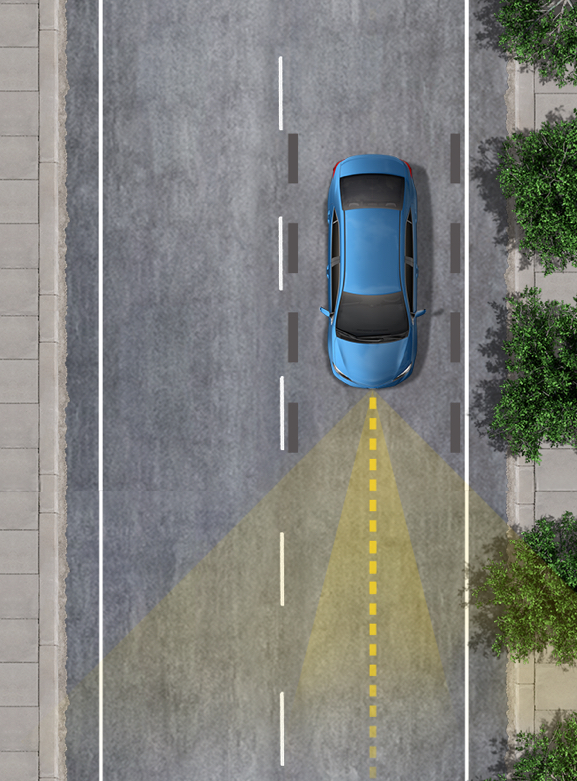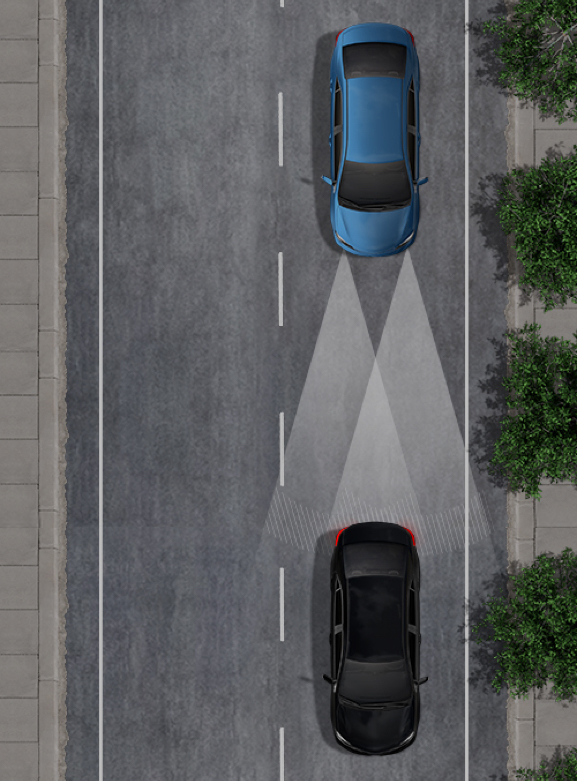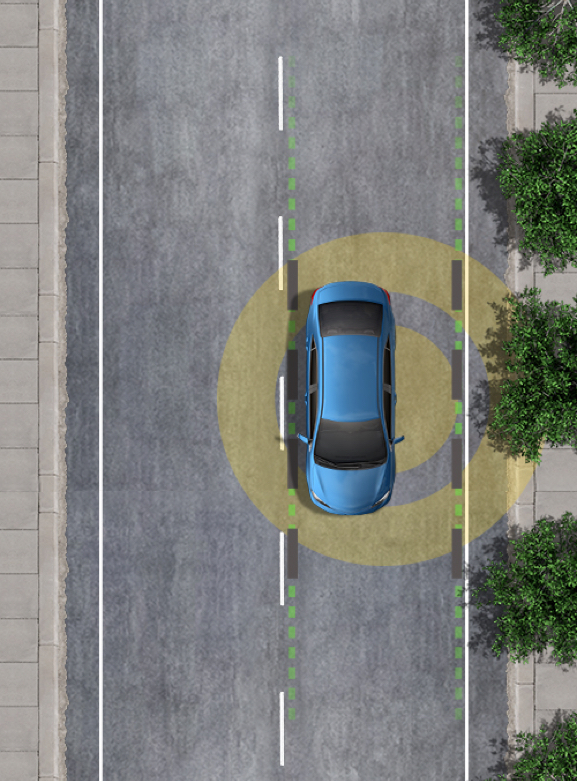A world without accidents. That’s a bold goal. It’s Toyota’s ultimate goal. Toyota Safety Sense (TSS) is the beginning of meeting this goal.
TSS-C
TSS-C features Pre-Collision System, Lane Departure Alert, and Automatic High Beam.
TSS-P
TSS-P enhances TSS-C, and adds Dynamic Radar Cruise Control to its suite of systems.
- Tacoma
- Tundra
- 4Runner
- Sequoia
TSS 2.0
Builds on TSS-P, and consists of up to six active safety and driver assistance systems.
- Prius
- Prius Prime
- Corolla Hatchback
- Corolla
- RAV4
- Venza
- Sienna
- C-HR
TSS 2.5+
TSS 2.5+ adds new capabilities to the Pre-Collision and Dynamic Radar Cruise Control Systems, and enhances Lane Tracing Assist.
- Highlander
- Camry
- 2022 Tundra
PRE-COLLISION SYSTEM
TSS-C – PRE-COLLISION SYSTEM2 Pre-Collision System (PCS) provides collision avoidance or collision mitigation support in certain situations where a frontal collision is likely to occur, and in some cases, will automatically apply the brakes to help the driver.
TSS-P – PRE-COLLISION SYSTEM WITH PEDESTRIAN DETECTION3 : PCS has been enhanced to also help detect pedestrians in certain situations.
TSS 2.0 – PRE-COLLISION SYSTEM WITH DAYTIME/LOW-LIGHT VEHICLE AND PEDESTRIAN DETECTION, PLUS DAYTIME BICYCLE DETECTION3 : PCS is also designed to help detect bicyclists in daytime situations, as well as vehicles and pedestrians in both daytime and low-light situations.
TSS 2.5+ – PRE-COLLISION SYSTEM WITH PEDESTRIAN (DAYTIME & LOW-LIGHT) & DAYTIME BICYCLE DETECTION, INTERSECTION SUPPORT & EMERGENCY STEERING ASSIST3 : PCS in TSS 2.5+ may warn you of oncoming pedestrians or vehicles when making a turn at an intersection and provide emergency braking in certain conditions. It also features Emergency Steering Assist, which is designed to stabilize the driver’s emergency steering maneuver and keep the vehicle in its lane when avoiding a pedestrian, cyclist or another vehicle.

LANE TRACING ASSIST
TSS 2.0 – LANE TRACING ASSIST8 : In models with Lane Tracing Assist (LTA), LTA works with Dynamic Radar Cruise Control to keep the vehicle centered in its visibly marked lane and preemptively avoid unintended lane departures.
TSS 2.5+ – LANE TRACING ASSIST WITH ENHANCED LINE & ROAD RECOGNITION8 : On vehicles equipped with TSS 2.5+, the lane recognition performance has been improved and the system may now recognize the line of travel in situations where road markings may have been temporarily interrupted.

AUTOMATIC HIGH BEAM
TSS-C, TSS-P, TSS 2.0, TSS 2.5+ – AUTOMATIC HIGH BEAM6 : All TSS packages feature Automatic High Beam (AHB) headlamps. The system reacts to oncoming headlamps or preceding taillamps, automatically switching from high-beam to low-beam and then back again once the coast is clear.

LANE DEPARTURE ALERT
TSS-C – LANE DEPARTURE ALERT4 : Lane Departure Alert (LDA) alerts you if you start to drift out of your lane when visible white/yellow lane markings are detected.
TSS-P – LANE DEPARTURE ALERT WITH STEERING ASSIST5 : In addition to LDA, some models with TSS-P may include the Steering Assist function and may also provide small corrective steering inputs.
TSS 2.0 – LANE DEPARTURE ALERT WITH STEERING ASSIST AND ROAD EDGE DETECTION5 : LDA for TSS 2.0 alerts you if you start to drift out of your lane when visible white/yellow lane markings, as well as road edges or curbs at certain speeds, are detected. Steering Assist may also provide gentle corrective steering inputs if action is not taken.

DYNAMIC RADAR CRUISE CONTROL
TSS-P – DYNAMIC RADAR CRUISE CONTROL7 : Intended for highway use, Dynamic Radar Cruise Control (DRCC), can automatically adjust your vehicle speed to maintain a preset following distance between you and the vehicle directly in front of you. The system is designed to work between speeds of approximately 40 km/h to 180 km/h.
TSS 2.0 – FULL SPEED RANGE DYNAMIC RADAR CRUISE CONTROL7 : Full Speed Range Dynamic Radar Cruise Control can also perform vehicle-to-vehicle distance control down to 0 km/h, and resume from a complete stop.
TSS 2.5+ – FULL SPEED DYNAMIC RADAR CRUISE CONTROL WITH CURVE SPEED MANAGEMENT7 : DRCC in TSS 2.5+ is enhanced with a Curve Speed Management function that will determine if the vehicle speed needs to be reduced when approaching a curve on the road and decelerate automatically when driving through a curve if required.


Every Toyota comes with the Star Safety System.
At Toyota, we know that your peace of mind while driving is paramount. That’s why we were the first full line manufacturer to introduce our Star Safety SystemTM as standard equipment with its six advanced accident avoidance technologies – including ABS, Traction Control, Vehicle Stability Control and more.
- Anti-lock Brake System (ABS)
- Brake Assist (BA)
- Electronic Brake-force Distribution (EBD)
- Vehicle Stability Control (VSC)
- Traction Control (TRAC)
- Smart Stop Technology
For more information about safety technology in Toyota vehicles please visit toyota.ca
1 Drivers should always be responsible for their own safe driving. Please always pay attention to your surroundings and drive safely. Depending on the conditions of roads, vehicles, weather, etc., the TSS systems may not work as intended. Please see toyota.ca, your local Toyota Dealer or Owner’s Manual for details.
2 The TSS Pre-Collision System is designed to help avoid or reduce the impact speed and damage in certain frontal collisions only. It is not a substitute for safe and attentive driving. System effectiveness depends on many factors, such as speed, driver input and road conditions. Please see toyota.ca, your local Toyota Dealer or Owner’s Manual for details.
3 The TSS Pre-Collision System is designed to help avoid or reduce the impact speed and damage in certain frontal collisions only. The Pedestrian Detection system is designed to detect a pedestrian ahead of the vehicle, determine if impact is imminent and help reduce impact speed. It is not a substitute for safe and attentive driving. System effectiveness depends on many factors, such as speed, size and position of pedestrians, driver input and weather, light and road conditions. Please see toyota.ca, your local Toyota Dealer or Owner’s Manual for details.
4 Lane Departure Alert is designed to read lane markers under certain conditions and provide visual and audible alerts when lane departure is detected. It is not a collision-avoidance system or a substitute for safe and attentive driving. Please see toyota.ca, your local Toyota Dealer or Owner’s Manual for details.
5 Lane Departure Alert with Steering Assist is designed to read lane markers under certain conditions and provide visual and audible alerts and slight steering force when lane departure is detected. It is not a collision-avoidance system or a substitute for safe and attentive driving. Please see toyota.ca, your local Toyota Dealer or Owner’s Manual for details.
6 Automatic High Beam system operates at speeds above approximately 34 km/h. Factors such as a dirty windshield, variable weather, lighting conditions and hilly terrain will limit effectiveness, requiring the driver to manually turn it off. Please see toyota.ca, your local Toyota Dealer or Owner’s Manual for details.
7 Dynamic Radar Cruise Control is designed to assist the driver and is not a collision-avoidance system or a substitute for safe and attentive driving practices. System effectiveness depends on many factors such as weather, traffic and road conditions. Please see toyota.ca, your local Toyota Dealer or Owner’s Manual for details.
8 Lane Tracing (Trace) Assist (LTA) is designed to read visible lane markers and detect other vehicles under certain conditions. When potential lane departure is detected, LTA provides a visual warning and either an audible alert or vibration in the steering wheel and can apply a slight steering force. It is not a collision-avoidance system or a substitute for safe and attentive driving. Effectiveness is dependent on many factors including road, weather and vehicle conditions. See Owner’s Manual for additional limitations and details.

